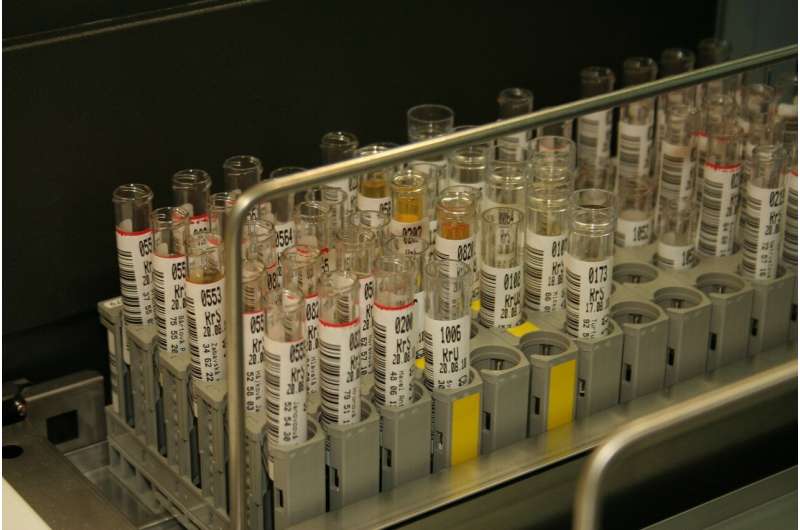This article has been reviewed according to Science X's editorial process and policies. Editors have highlighted the following attributes while ensuring the content's credibility:
fact-checked
trusted source
written by researcher(s)
proofread
Coca-Cola, rose wine, red wine and 50 shades of yellow: What the color of urine means

Red and yellow and pink and green—your urine can sing a rainbow too. You may be surprised to find out it can be purple and orange and blue. And a myriad of other unusual colors besides.
Urine acts as a medium through which the body can excrete several waste products. This includes nitrogenous waste from the breakdown of protein and muscle (in the form of urea and creatinine), and red blood cells. In addition, many different ingested compounds, including vitamins, medicines, and some from our diet work their way out of the body via urine.
But there are plenty of things that shouldn't be present in urine, and one important question a doctor should consider is: "What color is it?" Doing so can help point toward a diagnosis.
Red
Red urine usually signifies bleeding. This can come from anywhere in the urinary tract—from the kidneys to the bladder and the prostate gland, and all the tubing that connects them.
The appearance of blood varies according to volume and freshness and can produce many different colors. In high-volume bleeds, the urine can be so stained that it looks like red wine. Many conditions can cause bleeding, from kidney stones to cancer, to trauma and urinary tract infections.
But red urine can also come from eating too much beetroot.
Orange and yellow
Of course, we know that the color of urine in its normal form covers many shades of yellow—depending on how well hydrated you are. Dehydration makes for darker-yellow urine, sometimes verging on the cusp of orange, whereas good fluid intake makes for a dilute pale-yellow urine.
The compound that stains urine yellow is called urobilin. The process of making it starts with the breakdown of old red blood cells that are past their best and need to be removed from the circulation.
This process creates a compound called bilirubin. It is excreted partly via urine and partly via the gut since it is used by the liver to make bile, which is important in the breakdown and digestion of fats. Bile gets secreted into the gut and is lost in feces. These compounds in bile are what give feces its distinctive brown color.
When bile is unable to be released into the gut—perhaps as a result of gallstones or cancers blocking the bile ducts—bilirubin is absorbed back into the bloodstream and is then excreted via urine. This makes it darker—an orange or brownish color. Elevated bilirubin also makes the skin yellow. The condition is called obstructive jaundice.
Several medications, including the antibiotic rifampicin, can also stain urine orange.
Green and blue
Green and blue-colored urine is a somewhat rarer finding and will probably cause a fair amount of surprise on looking down into the toilet.
If you've excluded that it's not from the color of a toilet flush, there are reasons as to why your body might be producing green or blue urine. Dyeing substances that come from green (such as asparagus) or blue foods and drinks, and eaten in large amounts, might be the cause, as might certain medications such as antihistamines, anesthetics and vitamins.
Interestingly, some microbes can also make compounds with greenish colors. The bacterium Pseudomonas aeruginosa (named according to its verdigris color) produces green-blue pyocyanins. It is a rarer cause of urinary tract infections—which is often accompanied by a burning or stinging sensation when peeing.
Indigo or purple
Indigo or purple pee is rarer. One of the possible causes is porphyria (which means purple) and is a genetic family of conditions that affects the skin and nervous system.
Another is aptly called purple urine-bag syndrome, and is another bacterial phenomenon. This refers to a condition where bacteria in a patient with a catheter (a urine drain) make stains that color urine purple.
Violet or pink
Back to blood (and beetroot) again. In smaller amounts, these can stain urine a pink color, rather than a deep red. In this instance, urologists commonly liken the appearance to rose wine, rather than the deeper red of a cabernet sauvignon.
Other colors
There are some other urine colors to note outside of the rainbow.
Some are of a darker color, usually brown or black. Here, a doctor may draw a comparison to Coca-Cola. This is sometimes caused by the breakdown of muscle into a compound called myoglobin—this is associated with a serious condition called rhabdomyolysis, perhaps promoted by extreme exertion or taking certain medications.
It might also come from bilirubin—making urine so dark as to be brown rather than orange. But it can also be caused by blood, though this time, less fresh. Inflammation of the kidney—a condition called glomerulonephritis—can trigger bleeding that turns from red to brown as it moves through the urinary tract.
But finally, on the clear side of the spectrum, comes colorless urine. While it's preferable not to have concentrated yellow urine, large volumes of dilute urine might also signal disease, either diabetes or pathological overdrinking.
It just goes to show the vast number of different shades our urine can take on, and the sheer number of different conditions that they can signify. And this is by no means a complete list.
But, by understanding the causes of discolored urine, you too can be vigilant for the signs like bleeding that warrant a trip to your doctor. Or to pick up that water bottle for a much-needed swig.
This article is republished from The Conversation under a Creative Commons license. Read the original article.![]()




















